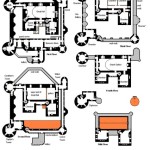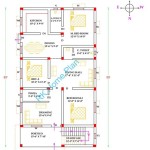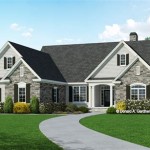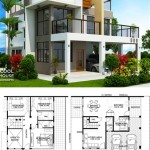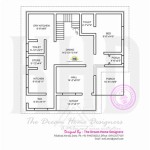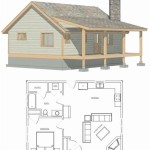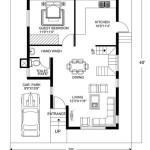East Facing 3 Bedroom House Plans: Maximizing Space and Sunlight
East facing house plans are often sought after due to their potential to bring in ample morning sunlight, contributing to a bright and cheerful living environment. Three-bedroom layouts are particularly popular for families or individuals who require extra space for guests, home offices, or hobbies. When designing an east-facing three-bedroom house, careful consideration must be given to spatial arrangement, window placement, and overall orientation to optimize natural light, ventilation, and energy efficiency.
This article will explore various aspects of east-facing three-bedroom house plans, outlining critical design considerations and providing insights into creating a comfortable and functional living space that takes full advantage of the morning sun.
Key Considerations for East Facing Homes
East-facing homes have unique advantages and challenges that need to be addressed during the planning and design process. Understanding these aspects is crucial for creating a house that is not only aesthetically pleasing but also comfortable and energy-efficient.
Sunlight Management: The primary benefit of an east-facing home is the abundance of morning sunlight. This natural light can brighten living spaces, reduce the need for artificial lighting, and potentially lower energy bills. However, it is essential to manage this sunlight effectively to prevent overheating, especially during warmer months. Strategies include incorporating shading devices such as overhangs, awnings, or strategically planted trees to block direct sunlight during the hottest parts of the day. Interior design should also consider the placement of furniture and sensitive materials that may be affected by prolonged sun exposure. The use of tinted windows or glazing can reduce glare and UV radiation.
Ventilation and Airflow: Proper ventilation is crucial for maintaining a comfortable indoor environment. East-facing homes benefit from natural airflow patterns, especially if windows are strategically placed to capture prevailing winds. Cross-ventilation, achieved by placing windows on opposite sides of the house, enhances airflow and helps to regulate indoor temperature. Passive cooling techniques, such as using ceiling fans or strategically placed vents, can further improve ventilation and reduce reliance on air conditioning.
Spatial Planning: The layout of an east-facing home should prioritize the placement of living areas that benefit most from morning sunlight. Bedrooms, living rooms, and dining areas are often ideally situated on the east side of the house to maximize exposure to natural light. Service areas, such as kitchens, bathrooms, and utility rooms, can be placed on the west side to minimize heat gain during the afternoon. This zoning approach helps to create a more comfortable and energy-efficient living environment.
Climate Considerations: The specific climate of the region where the house is being built significantly influences design decisions. In warmer climates, measures to prevent overheating are paramount. This may involve using reflective roofing materials, incorporating insulation in walls and ceilings, and providing ample shade. In colder climates, maximizing solar gain during the winter months is essential. Strategies include orienting the house to capture as much sunlight as possible and using thermal mass materials to store heat during the day and release it at night.
Optimizing the 3-Bedroom Layout
Designing a three-bedroom house plan requires careful consideration of space allocation, functionality, and privacy. The layout should cater to the specific needs of the occupants while maximizing the use of available space.
Master Suite Placement: The master bedroom suite is typically the largest bedroom and often includes a private bathroom and walk-in closet. In an east-facing home, placing the master bedroom on the east side allows the occupants to wake up to natural sunlight. The orientation of the windows should be carefully considered to provide optimal light while maintaining privacy. The master suite can also incorporate a small sitting area or balcony to enhance its functionality and appeal.
Secondary Bedroom Arrangements: The placement of the other two bedrooms depends on the overall design and the specific needs of the occupants. These bedrooms can be located on the east side of the house as well, or they can be placed on the north or south sides depending on the lot configuration and privacy requirements. It's essential to ensure adequate separation between the bedrooms and living areas to minimize noise transmission. Shared bathrooms should be easily accessible from both bedrooms.
Living and Dining Areas: The living and dining areas are often combined into a single open-plan space to maximize the feeling of spaciousness. In an east-facing home, these areas should be situated to take advantage of morning sunlight. Large windows or sliding glass doors can provide ample natural light and connect the interior spaces with the outdoors. The layout should allow for easy traffic flow and comfortable seating arrangements. The dining area should be located near the kitchen for convenient meal service.
Kitchen Design: The kitchen is the heart of the home and should be designed for functionality and efficiency. While it's not necessarily essential to place the kitchen on the east side, it should be well-lit and ventilated. Adequate counter space, storage, and appliance placement are crucial for creating a functional kitchen. The kitchen layout should also consider the proximity to the dining area and other living spaces to facilitate interaction and communication.
Bathroom and Utility Areas: Bathrooms and utility areas, such as laundry rooms, are typically placed on the west side of the house to minimize heat gain. These areas do not require as much natural light as living spaces, so their placement on the west side does not significantly impact their functionality. Adequate ventilation is essential in bathrooms to prevent moisture buildup and mold growth. The laundry room should be located near the bedrooms for convenient access.
Specific Design Elements for East Facing 3 Bedroom Houses
Beyond general layout considerations, specific design elements can further enhance the comfort, functionality, and aesthetics of an east-facing three-bedroom house.
Window Selection and Placement: Window selection is a critical aspect of east-facing house design. Large windows on the east side can maximize natural light, but it's important to consider the type of glass used. Low-E (low emissivity) glass can reduce heat gain and UV radiation while still allowing ample natural light. Window placement should also consider privacy and views. Strategically placed windows can frame scenic views and provide a connection to the outdoors. Hopper windows or awning windows can be used to provide ventilation even during rainy weather.
Shading Devices: Shading devices such as overhangs, awnings, and louvers can effectively block direct sunlight during the hottest parts of the day. Overhangs are particularly effective at blocking high-angle summer sun while allowing lower-angle winter sun to penetrate the interior. Awnings can be used to shade windows on the east side and can be retractable to allow for more sunlight during the winter months. Louvers can be adjusted to control the amount of sunlight entering the house and can also provide privacy.
Landscaping: Landscaping can play a significant role in controlling sunlight and improving the overall energy efficiency of an east-facing home. Deciduous trees planted on the east side can provide shade during the summer months and allow sunlight to penetrate during the winter. Vines growing on trellises can also provide shade and create a green screen. Ground cover plants can help to reduce heat reflection and maintain cooler temperatures around the house.
Material Selection: The choice of building materials can also impact the energy efficiency and comfort of an east-facing home. Reflective roofing materials can reduce heat gain in warmer climates, while thermal mass materials, such as concrete or brick, can store heat during the day and release it at night in colder climates. Insulated walls and ceilings can help to maintain a consistent indoor temperature and reduce energy consumption. The selection of interior finishes should also consider their impact on indoor air quality and the overall comfort of the living environment.
Interior Design Considerations: Interior design should complement the natural light and ventilation of an east-facing home. Light-colored walls and ceilings can reflect sunlight and make the interior spaces feel brighter and more spacious. The placement of furniture should consider the flow of natural light and air. Avoid blocking windows with large pieces of furniture. The use of natural materials, such as wood and stone, can enhance the connection to the outdoors. Plants can also add a touch of nature and improve indoor air quality.
Accessibility and Universal Design: Incorporating accessibility features into the design of an east-facing three-bedroom house can make it more comfortable and convenient for people of all ages and abilities. This includes wider doorways, ramps instead of steps, grab bars in bathrooms, and accessible kitchen layouts. Universal design principles aim to create a living environment that is usable by everyone, regardless of their physical abilities.
Designing an east-facing three-bedroom house involves careful planning and consideration of various factors. By understanding the unique advantages and challenges of east-facing homes, and by incorporating specific design elements to optimize sunlight, ventilation, and spatial arrangement, it is possible to create a comfortable, functional, and aesthetically pleasing living environment.

3bhk East Facing House Plan In First Floor 30x40 Site Plans 20x40 Single Design

Images By Riaz Ahmad On Mehendi 2bhk House Plan 30x40 Vastu Small Plans New

35x45 East Face 3bhk 3 Bed Room With Drawing House Plan Parking Porch As Per Vastu

Pin On Design

Modern House Plan 3 Bhk East Facing Small Design Plans Bungalow Floor

East Facing Vastu Home 40x60 Everyone Will Like Acha Homes

38x30 East Facing 3 Bed Room Best House Plan 3bhk With Living Dining Area Asper Vastu

3 Bed Room 4 East Facing House Plan 38x38 Feet Bhk Face With Puja

Best 3 Bhk House Plan For 60 Feet By 50 Plot East Facing

3 Bhk East Facing House Plan As Per Vastu 30 By Raeet

